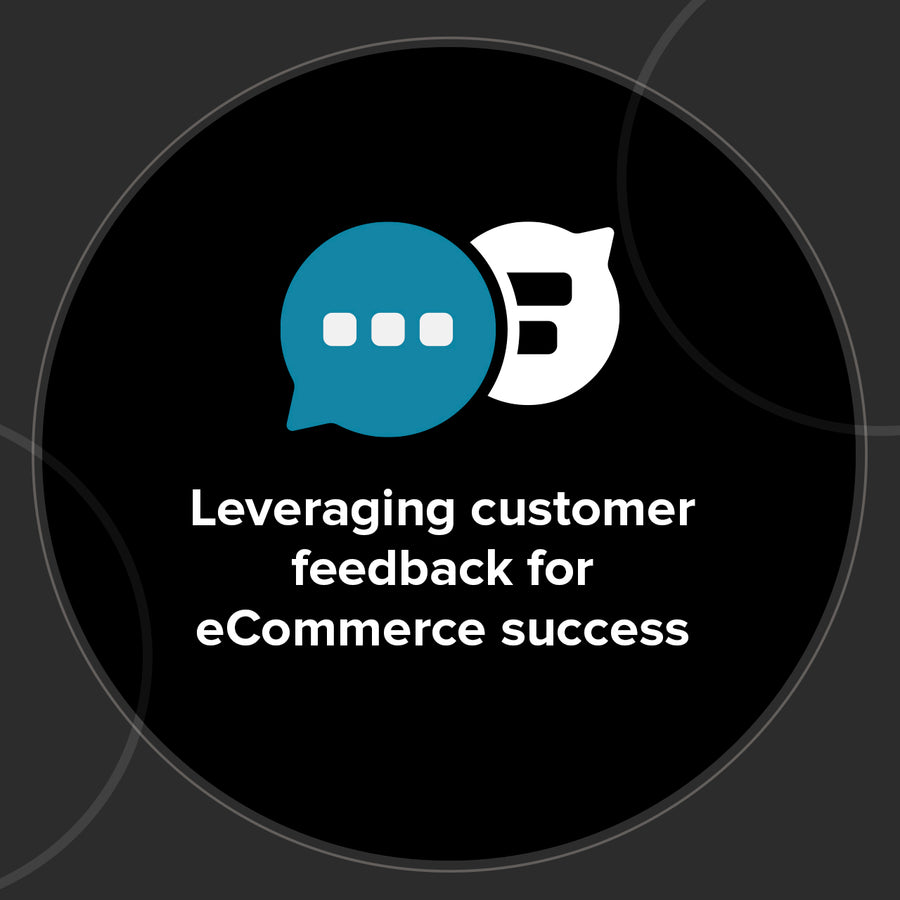Leveraging customer feedback for eCommerce success
22 September 2023

Understanding customers is a fundamental aspect of eCommerce success. For eCommerce business owners and digital marketers, customer feedback is not just a measure of satisfaction, but a critical resource for driving continuous improvement.
When managing sophisticated platforms like Magento or Shopify Plus, the array of features and customisation options can sometimes obscure the direction for development. However, customer feedback offers clear, actionable insights that can guide these decisions. Feedback not only highlights areas of concern but also provides specific reasons behind customer preferences and behaviours.
There exists a direct relationship between feedback and website improvements. Feedback helps you interpret specific issues, from checkout glitches to product search inefficiencies or clarity in product descriptions. By addressing these insights, businesses can make targeted improvements to their online stores, enhancing user experience and increasing conversion rates.
As we progress through this guide, we'll detail how to effectively leverage customer feedback. We will introduce strategies, tools, and best practices designed for individuals with a deep understanding of eCommerce. Whether you're an eCommerce expert or a focused digital marketer, the value of customer feedback cannot be understated. It serves as a foundation for informed decision-making and strategic website optimisation.
How to leverage feedback for eCommerce success:
- The Power of Feedback on Website Performance
- Techniques to Gather Feedback Effectively
- Analysing Feedback: Turning Words into Actionable Insights
- Enhancing the Customer Journey through Feedback
- Strategies to Boost Customer Retention
- Leveraging Feedback to Increase Average Order Value (AOV)
- Challenges and Limitations of Using Feedback
- Conclusion
- How Can Absolute Design Help?
The Power of Feedback on Website Performance
eCommerce platforms are complex systems with multiple layers of interactions. Ensuring optimal performance is crucial for maintaining user trust and achieving high conversion rates. While technical metrics and analytics provide a quantitative view of website performance, it's customer feedback that often unveils the qualitative aspects, delivering a fuller picture.
Pinpointing Performance Issues
User feedback is invaluable in detecting specific performance issues that might go unnoticed with standard monitoring tools. For instance, a page might load adequately in a test environment but could falter in real-world scenarios due to varied user behaviours, device compatibilities, or network conditions. Feedback from customers provides insights into such anomalies. They might report issues like sporadic website crashes, certain features not loading on specific devices, or even slow loading times during peak traffic hours.
Role of Feedback in Website Speed Optimisation
Website speed is paramount in eCommerce. A delay of even a few seconds can deter potential customers and impact sales. Feedback often acts as an early warning system in this context. Before a slow page speed reflects in bounce rates or cart abandonment statistics, customers might already be voicing their concerns. By heeding these warnings, businesses can proactively address speed bottlenecks, optimising code, refining server response times, or even reconsidering hosting solutions.
Enhancing Usability and Functionality Through Feedback
Beyond speed, usability is a cornerstone of a successful eCommerce platform. User feedback can shed light on navigation difficulties, unintuitive interfaces, or challenges in the checkout process. By systematically addressing these feedback points, businesses can refine the user journey, making it more intuitive and seamless. Moreover, feedback can highlight desired features or functionalities that customers find lacking, guiding the development roadmap to align more closely with user needs.
While technical tools and analytics play a pivotal role in assessing web performance, customer feedback offers a unique, user-centric perspective. By integrating feedback into performance evaluation processes, eCommerce businesses can achieve a balance between technical efficiency and user satisfaction, ensuring a holistic approach to website optimisation.
Techniques to Gather Feedback Effectively
For eCommerce professionals, sourcing feedback is as crucial as the insights derived from it. Harnessing customer opinions requires a combination of proactive and reactive methods.
Here, we outline several techniques that have proven effective for capturing feedback in the digital landscape.
Website Surveys
Utilising surveys can provide direct insights into specific areas of interest. Key methods include:
- Pop-ups: These can be timed to appear after a user has spent a certain amount of time on the site, ensuring they've had some interaction before being prompted.
- Exit-intent surveys: Triggered when users are about to leave the site, these can capture reasons for abandonment or gather suggestions for improvement.
- Page-specific feedback: By placing feedback options on particular pages, businesses can gather precise insights about that section of the website, be it product listings, checkout, or customer support.
Usability Testing
Inviting a subset of users to test website functionalities can yield invaluable observations. Conducting live sessions allows businesses to see how real users interact with their site, identifying any roadblocks or areas of confusion. Feedback gathered during these sessions is immediate and often highlights issues that might not be evident from analytics alone.
Feedback Forms
A more passive yet consistently effective method is the placement of feedback forms. These can be located in a site's footer, within user profiles, or other strategic locations. Forms allow users to provide feedback at their convenience, making it more likely they'll offer detailed and thoughtful responses.
Net Promoter Score (NPS)
NPS is a powerful metric to gauge customer loyalty and overall satisfaction. Customers are asked how likely they are to recommend the business to others, usually on a scale from 1 to 10. Analysing NPS can help businesses identify their promoters (loyal enthusiasts) and detractors (unsatisfied customers), guiding efforts to improve overall satisfaction.
Social Media Listening
In today's interconnected world, customers frequently voice their opinions on social platforms. Using tools to monitor mentions of your brand or website can capture unsolicited feedback, both positive and negative. This method also allows businesses to engage with customers directly, addressing concerns and building stronger relationships.
Incorporating these techniques into a feedback-gathering strategy ensures a diverse range of insights. The more avenues eCommerce businesses provide for feedback, the richer and more comprehensive the data becomes, ultimately paving the way for informed decision-making and optimisation.
Analysing Feedback: Turning Words into Actionable Insights
The acquisition of feedback is but the first step; its true value emerges from systematic analysis and interpretation. eCommerce professionals must sift through the feedback to discern genuine insights that can guide strategic decisions. In this section, we explore feedback analysis, focusing on distinguishing between qualitative and quantitative feedback, recognising patterns, and leveraging tools for sentiment analysis.
Qualitative vs Quantitative Feedback
Both qualitative and quantitative feedback offer distinct advantages:
- Quantitative feedback provides measurable, often numerical data that can be statistically analysed. Examples include ratings out of 10, percentage satisfaction scores, or response times. This type of feedback offers a broad overview, allowing businesses to identify general trends and performance metrics.
- Qualitative feedback, on the other hand, reveals the 'why' behind user responses. It's typically derived from open-ended questions, comments, or discussions, providing context and reasoning for customer sentiments. While it may not be as easily measurable as quantitative feedback, it offers richer insights into user experiences and specific pain points.
Identifying Patterns and Common Themes
Given the vast volume of feedback, especially for larger eCommerce platforms, it's essential to categorise and identify recurring patterns. Grouping feedback into themes, such as 'website navigation', 'checkout process', or 'product variety', can help prioritise areas of improvement.
Recognising patterns, such as multiple users reporting the same issue, can highlight critical concerns that require immediate attention.
Tools for Sentiment Analysis and Feedback Categorisation
Technological advancements offer a plethora of tools designed to assist in feedback analysis:
- Sentiment Analysis Tools: These tools evaluate the tone of feedback, determining whether comments are positive, negative, or neutral. By automating this process, businesses can quickly gauge overall customer sentiment without manual review.
- Feedback Categorisation Software: Such tools can automatically sort feedback into predefined categories based on keywords or phrases, facilitating quicker analysis and response.
- Visualisation Software: Tools that convert feedback data into visual formats, like graphs and heat maps, can be instrumental in highlighting trends and areas of concern at a glance.
The process of analysing feedback is as vital as its collection. It's through evaluation that eCommerce businesses can translate raw feedback into actionable strategies, ensuring that customer voices lead to tangible improvements.
Enhancing the Customer Journey through Feedback
The customer journey encompasses every interaction a user has with an eCommerce platform, from initial awareness to post-purchase engagement. Feedback provides a lens through which businesses can view this journey from the customer's perspective, identifying areas of excellence and those in need of refinement. Let's examine how feedback can be instrumental in elevating the customer journey.
Mapping the Customer Journey and Identifying Pain Points
A comprehensive understanding of the customer journey is foundational to any optimisation effort. By soliciting feedback at various touchpoints, businesses can create a detailed map of the customer experience. This might include stages such as product discovery, selection, checkout, and post-purchase interactions.
Feedback highlights specific pain points or friction areas within this journey. For instance, if multiple customers express difficulty in locating a particular product category or experience delays during checkout, these become clear areas for intervention.
Tailoring Content to User Needs Based on Feedback
Content, in the context of eCommerce, goes beyond just product descriptions. Feedback can reveal what information customers find most valuable, whether it's detailed product specifications, user reviews, or demonstration videos.
By understanding these preferences, businesses can tailor content to better align with user needs, enhancing product pages, FAQs, or even blog posts.
Optimising Site Navigation and Improving Page Layouts
The structure and layout of an eCommerce site play a pivotal role in the user experience. Feedback might indicate areas where site navigation is convoluted or where users frequently get "lost." Addressing these concerns can involve refining menu structures, enhancing search functionalities, or introducing clearer site breadcrumbs.
Similarly, feedback on page layouts can guide design choices. If users find a page cluttered or feel essential information is buried, redesigning these pages can lead to more intuitive user experiences and potentially higher conversion rates.
In essence, feedback serves as a roadmap, guiding eCommerce professionals towards creating a seamless and enjoyable customer journey. By addressing feedback-derived insights, businesses not only rectify existing issues but also pre-emptively enhance aspects of their online store, ensuring sustained user satisfaction and loyalty.
Strategies to Boost Customer Retention
Customer retention is a linchpin of sustainable eCommerce growth. Acquiring a new customer often costs significantly more than retaining an existing one. Moreover, loyal customers tend to spend more and advocate for the brand, amplifying its reach. Feedback is a powerful tool in this retention endeavour, providing clear directives on how to nurture and maintain strong customer relationships.
Below, we discuss strategies anchored in feedback that can significantly boost customer retention.
Personalising User Experience Based on Feedback
A personalised shopping experience can drastically enhance user engagement and loyalty. Feedback can provide insights into individual customer preferences, be it related to product types, content format, or even browsing habits.
Leveraging this feedback allows businesses to tailor user experiences. This can manifest as personalised product recommendations, content curation, or even bespoke offers and promotions targeting specific user segments.
Addressing Common Complaints and Resolving Them
Proactively addressing issues not only rectifies problems but also demonstrates a brand's commitment to its customers. Feedback will invariably highlight recurrent complaints or concerns. Prioritising these issues and addressing them head-on can prevent larger-scale customer dissatisfaction in the future.
Transparent communication is key. Informing customers about the steps taken in response to their feedback fosters trust and appreciation.
Enhancing Customer Support and Creating Responsive Feedback Loops
Exceptional customer support can turn potentially negative experiences into positive ones. Feedback can help identify areas where support may be lacking, whether it's in response times, resolution efficacy, or even the mediums of support offered (e.g., chat, email, phone).
Implementing responsive feedback loops, where customers are regularly prompted for their views and updated on previous feedback outcomes, establishes a two-way communication channel. This not only garners more feedback but also reinforces the notion that the business values its customers' opinions.
Feedback is an invaluable asset in the quest for customer retention. By listening to customers and actioning their insights, eCommerce businesses can foster an environment of trust and loyalty, ensuring sustained revenue and brand advocacy.
Leveraging Feedback to Increase Average Order Value (AOV)
Increasing the Average Order Value (AOV) is a strategic approach to maximising revenue without necessarily increasing the number of transactions. Feedback plays a pivotal role in informing strategies that can enhance AOV, offering insights directly from the customer base about their purchasing behaviours and preferences. Here's how feedback can be utilised to boost AOV.
Upselling and Cross-selling Strategies Inspired by Feedback
Feedback can highlight opportunities for upselling and cross-selling. Customers might provide insights into complementary products they wish were suggested during their purchase process, or higher-tiered products they'd consider if made aware.
Using this feedback, businesses can refine their product recommendations, ensuring that relevant upsell and cross-sell opportunities are presented at the right stages of the customer journey.
Streamlining the Checkout Process
A seamless checkout process can encourage customers to finalise their purchases and even add more to their carts. User feedback might indicate points of friction in the checkout process, such as cumbersome forms, lack of payment options, or unclear shipping information. Addressing these concerns and streamlining checkout can reduce cart abandonment and increase the likelihood of customers adding last-minute items, thus boosting AOV.
Implementing Loyalty Programmes and Incentives Based on Customer Preferences
Loyalty programmes are a proven method to increase both retention and AOV. Feedback can provide insights into what rewards or incentives customers value most, whether it's discounts, exclusive products, or early access to sales.
Tailoring loyalty programmes based on these preferences ensures that customers are incentivised to spend more per transaction. For instance, offering tiered rewards based on purchase value can motivate customers to reach higher spending thresholds.
Feedback is a potent tool for eCommerce businesses aiming to increase their AOV. By tuning into customer preferences and addressing their concerns, businesses can craft strategies that not only enhance the purchasing experience but also drive up the value of each transaction.
Challenges and Limitations of Using Feedback
Not all feedback will be equally useful, and certain challenges arise when interpreting and implementing customer insights. Here, we address some of the key challenges and limitations of using feedback and offer guidance on navigating them effectively.
Overcoming the Negativity Bias in Feedback
It's a well-observed phenomenon that individuals are often more inclined to voice negative experiences than positive ones. This can skew feedback, making it seem as though issues are more widespread or severe than they might be in reality.
To address this, businesses should actively solicit feedback from all customers, not just those who spontaneously provide it. This can help balance the feedback pool and ensure a more accurate representation of overall customer sentiment.
Ensuring Feedback is Representative of Your Entire Customer Base
A related challenge is ensuring feedback is representative. Often, feedback may predominantly come from a vocal minority, potentially leading businesses to make decisions based on the preferences or concerns of a small segment of their customer base.
Employing diverse feedback-gathering methods, such as surveys across different touchpoints, can help capture a broader spectrum of opinions. Additionally, demographic analysis of feedback providers can ensure diverse customer segments are adequately represented.
Distinguishing Between Subjective Opinions and Objective Issues
Feedback, by its very nature, will contain both subjective opinions and objective issues. While one customer might dislike a particular design element for personal reasons, another might highlight a genuine usability issue. Distinguishing between the two is important.
Analysing aggregate feedback can help here. If a significant portion of feedback converges on a specific issue, it's likely an objective concern. In contrast, isolated or infrequent comments might represent more personal preferences.
In essence, while feedback offers actionable insights, it's imperative to approach it critically. By recognising the inherent challenges and biases in feedback collection and analysis, eCommerce businesses can extract meaningful, actionable insights that genuinely align with the needs and desires of their broader customer base.
Conclusion
Feedback, when systematically collected and analysed, provides a data-driven foundation upon which businesses can make informed decisions. It acts as a barometer for customer satisfaction and offers insights into areas requiring optimisation. Moreover, feedback-driven changes signal to customers that their opinions are valued, thus fostering trust, and enhancing brand loyalty.
However, sporadic feedback collection is insufficient. For it to be truly transformative, feedback must be consistently gathered, meticulously analysed, and effectively actioned. eCommerce businesses must institutionalise feedback collection, ensuring its regularity and its representation across the diverse customer base.
As the eCommerce sector continues its upward trajectory, the role of customer feedback as a determinant of success becomes increasingly pronounced. Embracing feedback not only refines the online store but also strategically positions businesses to thrive in a competitive marketplace.
How Can Absolute Design Help?
Ready to elevate your online presence? At Absolute Design, we're more than just a Shopify Plus and Magento agency. We combine cutting-edge website development with strategic branding, crafting digital experiences that resonate with your audience. Don't settle for the ordinary. Partner with Absolute Design today and let's transform your vision into a digital reality. Reach out to our team and take the first step towards a future defined by excellence.
Contact Us to discuss how we can help increase sales and boost your online performance!
INSIGHTS
20 February 2025
100% Client Coverage for Urgent Adobe Security Patch APSB25-08 - February 2025
CASE STUDIES
Are you excited to get your next project up and running? Or are you unsure what is dragging you down?









